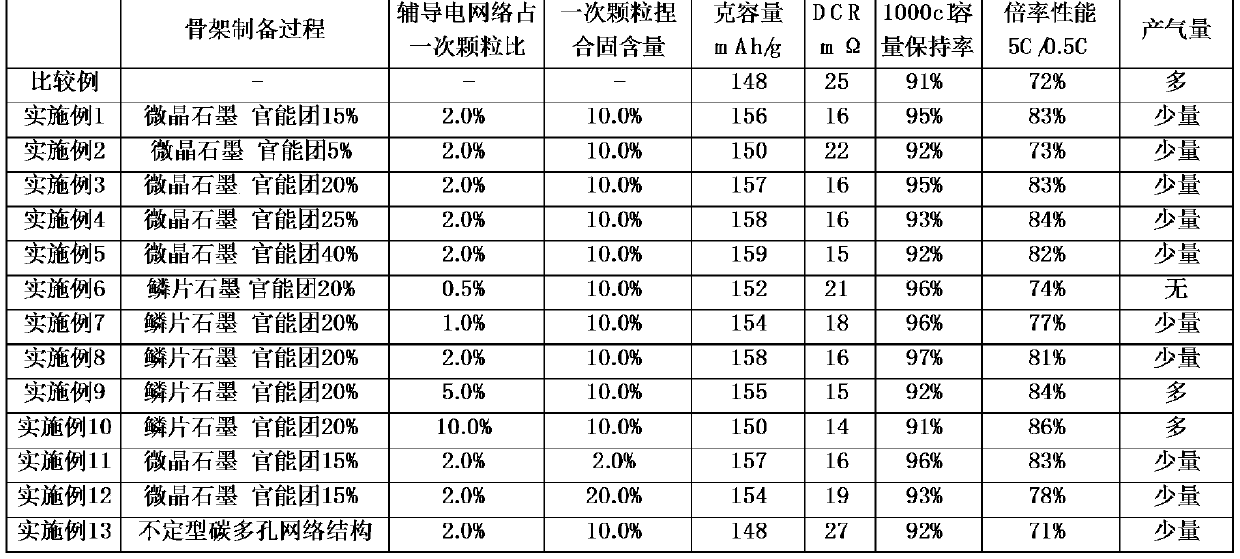Lithium titanate negative electrode material and preparation method thereof
A negative electrode material, lithium titanate technology, applied in battery electrodes, structural parts, electrical components, etc., can solve the problems of large contact resistance, small contact area, large gas production, etc., to reduce contact resistance, increase contact area, and easily fill effect
- Summary
- Abstract
- Description
- Claims
- Application Information
AI Technical Summary
Problems solved by technology
Method used
Image
Examples
Embodiment 1
[0041] Embodiment 1, differs from comparative example in that this embodiment comprises the following steps:
[0042] Step 1, precursor preparation: lithium titanate, methyl methacrylate, sodium lauryl sulfate (mass ratio is lithium titanate: methyl methacrylate: sodium lauryl sulfate = 100:2:1), after mixing NMP (solid content is 10%) and kneading, the revolution is 30 rpm, and the rotation is 300 rpm; kneading for 4 hours to obtain a uniformly dispersed precursor;
[0043] Step 2, preparation of worm-like graphene-dominated conductive network structure: select microcrystalline graphite as raw material, then add concentrated sulfuric acid and potassium permanganate for oxidative intercalation, and obtain graphite oxide whose oxygen-containing functional group accounts for 15% of the total mass of graphite oxide. Then heat treatment to obtain worm-like graphene for use;
[0044] Step 3, filling: Vacuum the worm-like graphene obtained in step 2, then place it in the precursor ...
Embodiment 2
[0047] Embodiment 2 is different from Embodiment 1 in that this embodiment includes the following steps:
[0048] Step 2, preparation of worm-like graphene-dominated conductive network structure: select microcrystalline graphite as raw material, then add concentrated sulfuric acid and potassium permanganate for oxidative intercalation to obtain graphite oxide whose oxygen-containing functional group accounts for 5% of the entire graphite oxide mass, Then heat treatment to obtain worm-like graphene for use;
[0049] The rest are the same as in Embodiment 1 and will not be repeated here.
Embodiment 3
[0050] Embodiment 3 is different from Embodiment 1 in that this embodiment includes the following steps:
[0051] Step 2, preparation of worm-like graphene-dominated conductive network structure: select microcrystalline graphite as raw material, then add concentrated sulfuric acid and potassium permanganate for oxidative intercalation, and obtain graphite oxide whose oxygen-containing functional group accounts for 20% of the mass of the entire graphite oxide. Then heat treatment to obtain worm-like graphene for use;
[0052] The rest are the same as in Embodiment 1 and will not be repeated here.
PUM
| Property | Measurement | Unit |
|---|---|---|
| diameter | aaaaa | aaaaa |
| particle diameter | aaaaa | aaaaa |
Abstract
Description
Claims
Application Information
 Login to View More
Login to View More - R&D
- Intellectual Property
- Life Sciences
- Materials
- Tech Scout
- Unparalleled Data Quality
- Higher Quality Content
- 60% Fewer Hallucinations
Browse by: Latest US Patents, China's latest patents, Technical Efficacy Thesaurus, Application Domain, Technology Topic, Popular Technical Reports.
© 2025 PatSnap. All rights reserved.Legal|Privacy policy|Modern Slavery Act Transparency Statement|Sitemap|About US| Contact US: help@patsnap.com

